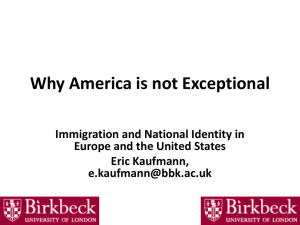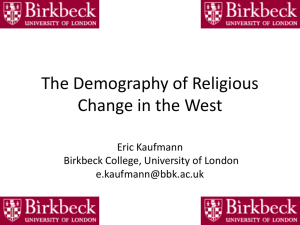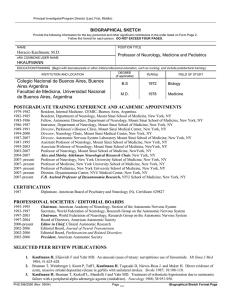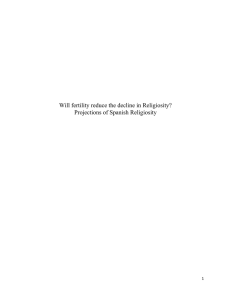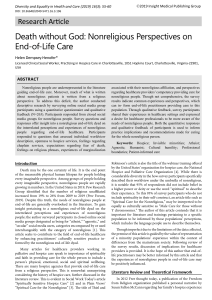Demographic Trends in Religion
advertisement
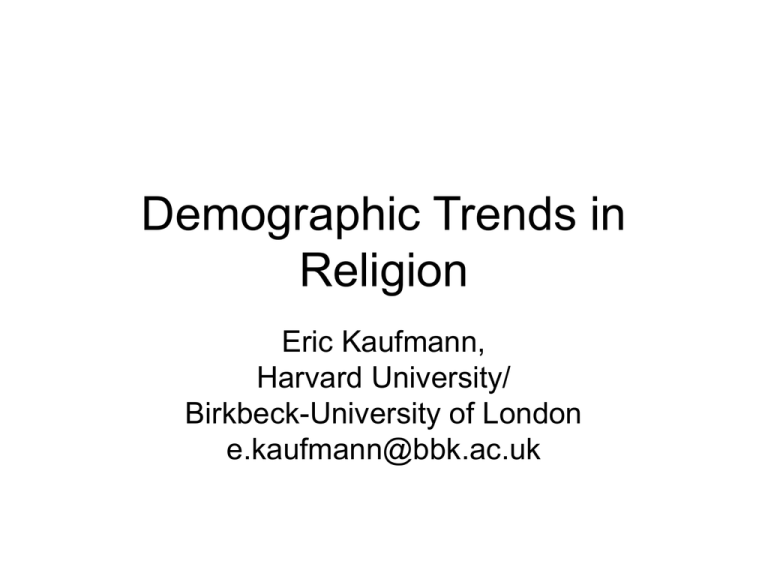
Demographic Trends in Religion Eric Kaufmann, Harvard University/ Birkbeck-University of London e.kaufmann@bbk.ac.uk 2 Aspects of Religion 1. Power of Religious Institutions over State 2. Individual piety • I focus on second aspect – tends to affect the first Past and Projected Global Religious Affiliation (World Religious Database) 45 40 35 30 1900 25 1970 20 2000 15 2025 10 5 0 Christian Muslim Hindu Nonreligious + Atheist Other • Based on affiliation (ie baptism for Christians) • Applying affiliation data to country demographic projections Church of England Baptisms as % of live births 0.8 0.7 0.6 0.5 0.4 0.3 0.2 0.1 0 1900 1910 1920 1930 1940 1950 1960 1970 1980 1990 2000 Broad Trends • Secularization: Catholic and part-Catholic Europe + Canada/Australasia/’blue’ states + southern cone of Latin America + global elite • Stability: Protestant Europe + USA+Hinduism • Resurgence: Islam, Pentecostalism (Asia, Latin America + Global South) Demography is Key • Inglehart: more are born in religious countries, so make up a larger share of global total. ***Send immigrants to nonreligious countries • Lesthaeghe: once everyone has access to contraception and family planning, values matter more for fertility • Conclusion: Some may become secular, but more will become religiously conservative Religiosity and Fertility: Europe and USA TFR Austria 2001 Switzerland 2000 Roman Catholics 1.32 1.41 Protestants Muslims Others Without Total 1.21 2.34 1.44 0.86 1.33 1.35 2.44 1.74 1.11 1.5 United States, 2006 (GSS) TFR Wrong Not wrong Diff Homosexuality 2.5 1.98 0.52 Abortion 2.47 1.83 0.64 Will They Keep the Kids? • Yes • ‘Strict’ religions more successful in inspiring commitment, retaining members • High fertility + high retention = high growth • Hutterites: 400 in 1880, 50,000 today. From .7% to 3.3% of Canadian prairie farm population, 1951-81 • Mormons: now outnumber Jews for those born after 1945 Attendance at Religious Services, by Faith and Age, RC 2004 ESS Weekly Attendance Prot 50% 45% 40% 35% 30% 25% 20% 15% 10% 5% 0% RC/Prot Eastern Muslims 18-24 25-34 35-44 45-54 55-64 65+ •Muslims will grow from 3-5% of W. Europe’s population to region of 12-15% by 2050 Projected Muslim Population of Austria to 2051, 36 Scenarios Source: Goujon et al. 2006 Projected Nonreligious Population of Austria to 2051, 36 Scenarios Source: Goujon et al. 2006 Similar Dynamics in USA Source: ‘The Moment of Truth’, Ha’aretz, 8 February 2007 Attitudes to Shari'a and Fertility, Islamic Countries, by Urban and Rural, 2000 WVS (Muslims Only) 3.5 Children Ever Born 3.3 3.1 city > 100k 2.9 town < 10k 2.7 2.5 2.3 2.1 1.9 1.7 1.5 Str. Agree Agree Neither Disagree Str. Disagree Source: WVS 1999-2000. N = 2796 respondents in towns under 10,000 and 1561 respondents in cities over 100,000. Asked in Algeria, Bangladesh, Indonesia, Jordan, Pakistan, Nigeria and Egypt. Conclusion • Religious – especially conservative religious, have larger families, retain members well • State religious authorities matter more for fertility in authoritarian societies; conservative movements and individuals count for more in democratic ones • Expect a growth in conservative Islam, Judaism and Christianity; Some erosion of moderate religion; Only Catholic Europe will see much secularization Demographic Trends in Religion Eric Kaufmann, Harvard University/ Birkbeck-University of London e.kaufmann@bbk.ac.uk
